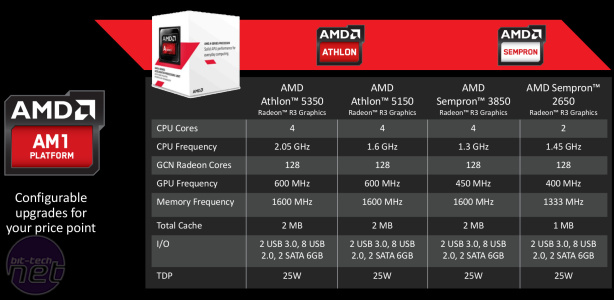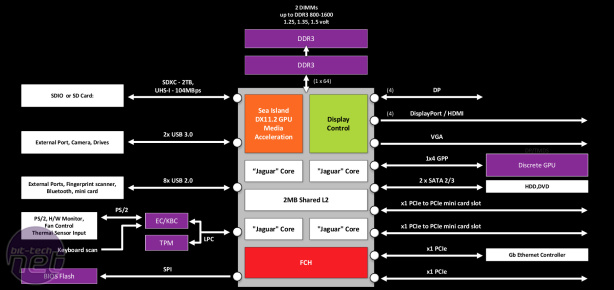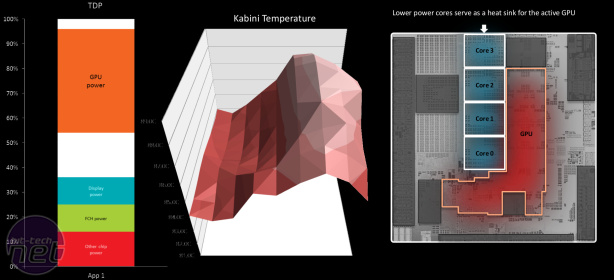
AMD has officially launched its desktop Kabini products, in the form of AM1 Accelerated Processing Units (APUs) designed for the entry-level market and bearing the Sempron and Athlon brands.
Designed to compete with Intel's Bay Trail, the Kabini desktop parts have been created to reflect what AMD claims is the changing face of every-day computing: an increase in the number of applications, like office suites and web browsers, that can make use of GPU acceleration to improve performance. That's something that an APU can do well, of course, but Kabini is more than just a slightly faster version of what has gone before.
The new AM1 platform, as Kabini will be known at retail, represents the company's first-ever socket-based system-on-chip (SoC) design, which AMD has dubbed 'System in a Socket.' The Kabini SoC design will be provided as a PGA-based, user-replaceable processor which fits into the new FS1b socket type. Unlike Intel's lower-wattage Bay Trail, which is BGA and soldered to the motherboard at the factory, AM1 owners will have the option of after-market upgrades.
The Kabini chips that form AM1 all have a similar feature set: an SoC design featuring up to four Jaguar CPU cores and Graphics Core Next (GCN)-based Radeon graphics with DirectX 11.2 and OpenGL 4.3 support - no word yet on Microsoft's as-yet unreleased DirectX 12 - and support for two USB 3.0 ports, eight USB 2.0 ports and two SATA 6Gb/s ports, all without the need for an external chipset. Manufacturers who need more are, of course, welcome to add extra chips as required.
The bottom of the Kabini desktop brand will be the AMD Sempron 2650: two 1.45GHz Jaguar cores, 128 Radeon cores running at 4000MHz, 1MB of cache and support for 1,333MHz memory. Moving up the ladder is the Sempron 3850: four 1.3GHz Jaguar cores, the same 128 Radeon cores but running at 450MHz, 2MB cache and support for 1,600MHz memory.
The higher-end Athlon range starts with the Athlon 5150: four 1.6GHz Jaguar cores, 128 Radeon cores running at 600MHz, 2MB cache and the same 1,600MHz memory support. The range tops out with the Athlon 5350, with four 2.05GHz Jaguar cores and the same cache, graphics and memory support. All four Kabini chips will, interestingly, come in at identical 25W thermal design profiles (TDPs) - higher, unfortunately, than Intel's BGA-only Bay Trail designs.
AMD looks to be pushing Kabini on the desktop against Bay Trail on three fronts: wider software support for older 32-bit and 64-bit operating systems; higher overall compute performance; and price. The latter is perhaps the most surprising: the bottom-end Sempron 2650 will cost just $31 per unit in trays of a thousand, with the Sempron 3850 stretching to $36; the Athlon 5150 will cost $45 per unit in the same volume, with the top-end Athlon 5350 fetching $55. FS1b motherboards will cost around $25-$35, the company has confirmed, a price point reached by the Kabini SoC taking over tasks that would have previously required an external chipset.
AMD has named ASrock, Asus, Biostar, Gigabyte, MSI and ECS Elitegroup as hardware partners on Kabini, each of whom plans to launch low-cost FS1b motherboards in micro-ATX and the compact mini-ITX formats. Formal retail pricing has not been provided as yet.
According to AMD's own internal testing, the new Jaguar cores - the same architecture found in the Xbox One and PS4 games consoles - offer considerable advantages over their predecessors. As well as boosts to low-power operation, the company is claiming a 17 per cent boost in instructions per cycle (IPC) over the E1-1500 Bobcat equivalent. Under PCMark 7, the company claims, that translates to a jump for the Sempron 2650 from the E1-1500's 1125 points to over 1300.
Higher up the rankings, the Athlon 5350 doubles the Cinebench R15 single-core benchmark compared to the AMD E-350, while its extra CPU cores mean a quadrupling in the multi-core tests. How these will compare to the same benchmark on Intel's latest low-power chips remains to be seen.
A particularly interesting aspect of AMD's Kabini design comes from its dynamic power management. During GPU-heavy activity, the less-loaded CPU cores act as a heatsink to draw heat away from the GPU; when the CPU is heavily loaded, the GPU is used in a similar manner. When both are loaded, of course, there'll likely be some down-clocking - but it's a system which should allow CPU- or GPU-bound applications to run at a higher speed than would otherwise be possible.
UPDATE
The first UK retailers have gone live with AM1 parts, offering the Athlon 5350 for £39.99, the Athlon 5150 for £37.99, the Sempron 3850 for £29.99 and the Sempron 2650 for £25.99. Motherboards range in price from £26 up to £38.
Designed to compete with Intel's Bay Trail, the Kabini desktop parts have been created to reflect what AMD claims is the changing face of every-day computing: an increase in the number of applications, like office suites and web browsers, that can make use of GPU acceleration to improve performance. That's something that an APU can do well, of course, but Kabini is more than just a slightly faster version of what has gone before.
The new AM1 platform, as Kabini will be known at retail, represents the company's first-ever socket-based system-on-chip (SoC) design, which AMD has dubbed 'System in a Socket.' The Kabini SoC design will be provided as a PGA-based, user-replaceable processor which fits into the new FS1b socket type. Unlike Intel's lower-wattage Bay Trail, which is BGA and soldered to the motherboard at the factory, AM1 owners will have the option of after-market upgrades.
The Kabini chips that form AM1 all have a similar feature set: an SoC design featuring up to four Jaguar CPU cores and Graphics Core Next (GCN)-based Radeon graphics with DirectX 11.2 and OpenGL 4.3 support - no word yet on Microsoft's as-yet unreleased DirectX 12 - and support for two USB 3.0 ports, eight USB 2.0 ports and two SATA 6Gb/s ports, all without the need for an external chipset. Manufacturers who need more are, of course, welcome to add extra chips as required.
The bottom of the Kabini desktop brand will be the AMD Sempron 2650: two 1.45GHz Jaguar cores, 128 Radeon cores running at 4000MHz, 1MB of cache and support for 1,333MHz memory. Moving up the ladder is the Sempron 3850: four 1.3GHz Jaguar cores, the same 128 Radeon cores but running at 450MHz, 2MB cache and support for 1,600MHz memory.
The higher-end Athlon range starts with the Athlon 5150: four 1.6GHz Jaguar cores, 128 Radeon cores running at 600MHz, 2MB cache and the same 1,600MHz memory support. The range tops out with the Athlon 5350, with four 2.05GHz Jaguar cores and the same cache, graphics and memory support. All four Kabini chips will, interestingly, come in at identical 25W thermal design profiles (TDPs) - higher, unfortunately, than Intel's BGA-only Bay Trail designs.
AMD looks to be pushing Kabini on the desktop against Bay Trail on three fronts: wider software support for older 32-bit and 64-bit operating systems; higher overall compute performance; and price. The latter is perhaps the most surprising: the bottom-end Sempron 2650 will cost just $31 per unit in trays of a thousand, with the Sempron 3850 stretching to $36; the Athlon 5150 will cost $45 per unit in the same volume, with the top-end Athlon 5350 fetching $55. FS1b motherboards will cost around $25-$35, the company has confirmed, a price point reached by the Kabini SoC taking over tasks that would have previously required an external chipset.
AMD has named ASrock, Asus, Biostar, Gigabyte, MSI and ECS Elitegroup as hardware partners on Kabini, each of whom plans to launch low-cost FS1b motherboards in micro-ATX and the compact mini-ITX formats. Formal retail pricing has not been provided as yet.
According to AMD's own internal testing, the new Jaguar cores - the same architecture found in the Xbox One and PS4 games consoles - offer considerable advantages over their predecessors. As well as boosts to low-power operation, the company is claiming a 17 per cent boost in instructions per cycle (IPC) over the E1-1500 Bobcat equivalent. Under PCMark 7, the company claims, that translates to a jump for the Sempron 2650 from the E1-1500's 1125 points to over 1300.
Higher up the rankings, the Athlon 5350 doubles the Cinebench R15 single-core benchmark compared to the AMD E-350, while its extra CPU cores mean a quadrupling in the multi-core tests. How these will compare to the same benchmark on Intel's latest low-power chips remains to be seen.
A particularly interesting aspect of AMD's Kabini design comes from its dynamic power management. During GPU-heavy activity, the less-loaded CPU cores act as a heatsink to draw heat away from the GPU; when the CPU is heavily loaded, the GPU is used in a similar manner. When both are loaded, of course, there'll likely be some down-clocking - but it's a system which should allow CPU- or GPU-bound applications to run at a higher speed than would otherwise be possible.
UPDATE
The first UK retailers have gone live with AM1 parts, offering the Athlon 5350 for £39.99, the Athlon 5150 for £37.99, the Sempron 3850 for £29.99 and the Sempron 2650 for £25.99. Motherboards range in price from £26 up to £38.

MSI MPG Velox 100R Chassis Review
October 14 2021 | 15:04











Want to comment? Please log in.